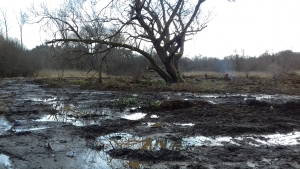Alverstone Marsh
Nearly two decades ago Gift to Nature and its predecessor organisation worked with landowners, the Isle of Wight Council, the Environment Agency and Natural England on the management and conservation of the 200ha Alverstone Marshes SSSI. There are two particular achievements worthy of note. The first is the successful five year campaign with Natural England to raise the official status of the overall SSSI from ‘unfavourable declining’ to ‘favourable improving’ through targeted habitat restoration work with 5 landowners. The second is the extraordinary archaeological and palaeoecological find made during Gift to Nature works at Alverstone bridge in 2005. This is still being investigated by the Museum of London and the IW archaeology team but is a nationally significant find spanning Roman to Medieval artefacts and structures linked to a mill and a river crossing.
In 2005 a JCB hired by the Island 2000 Trust began removing the surface of a marshy area as the first step to create a pond for water voles and dragon flies at Alverstone on the Eastern Yar River. The following day as the digger excavated deeper its metal teeth crunched onto the cobbled surface.
This was just the first in a series of extraordinary discoveries that followed on an almost daily basis. More and more structures were identified along with many human artefacts and biological records preserved intact in the peaty mud.
We suddenly found ourselves managing an archaeological crisis dig with just twelve weeks to excavate the incredible organic and man made finds before the site flooded in the coming autumn rains.
A Race Against Time
The archaeological dig was a vast undertaking. Every item had to be carefully excavated, recorded, mapped and removed for preservative processing.
1,840 wooden components were recovered including 345 shaped stakes and posts, planks wedges and dowels including the huge oak stakes used to hold together the cobbled surface. Among the hundreds of associated finds were sackloads of flint cobbles, pottery and glass, iron and copper alloy objects including clasps, buckles, bracelets, nails, fasteners, spear heads, crossbow bolts, coins and pen nibs. The organic remains included animal bones, pollen, leaves, fungi, seeds and even spiders, all miraculously preserved in this giant peat time capsule.
Once unearthed these thousands of objects were despatched to specialist centres for safe storage and analysis. The timber has gone to Flag Fen Wetland Archaeology Centre in Cambridgeshire, the metal objects to the York Archaeological Trust and the biological remains to the University of Portsmouth.
The biological material alone will allow archaeologists to recreate not only a picture of the flora of the ancient Wight, but also its climate. However the analysis will take years and the interpretation will likely go on for decades.
In the meantime, as we await the results, can we can make some intuitive guesses?
Alverstone is 5km from the mouth of the river. The rising of sea level that followed the last Ice Age (about 12,000 years ago) not only flooded the Solent Valley about 8,000 years ago but also flooded the river valleys feeding the Solent River, most notably the Itchen-Test Valley, now Southampton Water, and the estuaries of the lower Medina, Wootton and the West Wight. Upstream we can see the silted up historic traces of this in our geology, in the layers of alluvium deposited high up the Medina and Eastern and Western Yars.
The Solent was much narrower. Trade across the seas had been important to the Island since the beginning of the Bronze Age, about 2,300BC. If the Island was to share in the benefits of using the new metal technology it had to import it by exporting goods or services, as no metals occur in the geology of the Island. Stone Age agriculture had become well established about 3,500BC and the Island probably bought metal imports through farming exports as well as quarried stone and later Island pottery.
For the moment we cannot put accurate dates on the finds at Alverstone.
The Iron Age built on the agricultural achievements of the Bronze Age. This period saw the development of sophisticated trading with metal coins and starting to develop major towns. The Roman finds are in themselves interesting. Further excavations at Brading Villa, 2km from Alverstone may bring to light further insights into life on Roman Vectis.
We must now await the specialist analysis of the funds for further news. A geophysical survey (using a sort of underground radar) could be useful in tracing some of the underground structures, to see if any more have survived and pinpoint where further digs could in future take place. Surely this important site deserves further attention?
